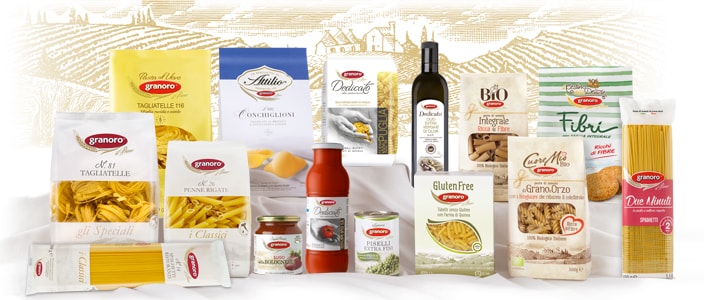-
In Italy, the Decree of the President of the Republic No.187 dated 09/02/2001 clearly defines the minimum characteristics for this type of product, as shown in the table here below: Product Max. humidity Max. ash Min. proteinType “00” soft wheat flour 14.50% 0.55% 9.00%Semolina 14.50% 0.90% 10.50%Reference: Decree of the President of the Republic No. 187 dated 9 February 2001. Ash and protein values calculated on dry product. Permitted humidity level of up to 15.5% if marked on the label. Protein: Kjeldahl nitrogen * 5.7
-
Soft wheat flour is produced by milling soft wheat, Triticum vulgare, a wheat with a floury structure that when milled produces a soft, white flour used to make bread, bread-related products and pastries.
-
The types of flour sold are classed as ”00”, “0”, “1”, “2” and whole wheat.The “00”, “0”, “1” and “2” classes indicate the various degrees of refinement of soft wheat flour, that is to say the percentage of wheat grain that will be contained in the finished product.Type “00” flour, with a sifting of 50%, is extremely white as it is the most refined and is obtained from the heart of the wheat grain, meaning it is completely free of bran particles.Type “0” flour, with a sifting of 72%, is less refined than type “00” and contains a greater amount of bran, which is found in the external part of the wheat grain.Type “1” and “2” flours are the least refined, with a degree of sifting of 80% and 85% respectively.Finally, there is whole wheat flour, which only undergoes the first milling process and is not sifted. Whole wheat flour contains all of the external parts of the wheat grain, such as bran, and is richer in protein.Granoro Flour is classed as type “00”.
-
Granoro Type
-
Durum wheat semolina is the product obtained from milling durum wheat (Triticum durum). It is distinguished by grains with a vitreous structure, which when milled produce a golden-yellow flour with shard-edged granules, known as semolina, generally used in the pasta industry.Durum wheat semolina is obtained from milling durum wheat, Triticum durum, the grains of which have a vitreous structure. When milled, this wheat produces a golden-yellow flour with shard-edged granules, known as semolina, generally used in the pasta industry.
-
Granoro durum wheat semolina is recommended for the preparation of fresh pasta, couscous and Gnocchi alla Romana. Its grain size makes it especially suitable for preparing traditional semolina soup.Granoro durum wheat semolina is available in 500 g packs.
-
Remilled durum wheat semolina is obtained from traditional semolina milled to produce a finer product. This means it has a finer grain size than the semolina from which it was produced, but preserves its characteristic amber yellow colour and has good water absorption properties, resulting in good production yields. Mainly produced in the south of Italy, it is best known for the traditional Pugliese bread that it is used to produce and can be used as it is or mixed with soft wheat flour for the production of homemade bread, homemade pasta and traditional desserts. Granoro produces it in convenient 1 kg packs.
-
Thanks to its grain size, Granoro remilled semolina is recommended for bread making and preparing homemade fresh pasta. When mixed with Type “00” flour, it adds greater fragrance to leavened doughs for the preparation of focaccias and pizzas. It is also excellent for fried foods, ensuring the result is crisp and golden.
-
The various types of flour are defined by a specific law (Law 580 4 July 1967), which governs the processing and sale of cereals and specifies the limits of some analytical properties such as humidity, ash, cellulose and the gluten content. The quality of a flour is not just assessed in terms of its chemical composition, but is also based on the rheological characteristics of the dough. To the naked eye, durum wheat semolina and remilled semolina differ from soft wheat flour in terms of grain size, that is to say the degree of refinement, which is less accentuated in remilled semolina and even less so in semolina in packs. They also differ in colour, golden yellow for semolina and pure white for soft wheat “00” flour.
-
Granoro produces its type “00” flour by selecting and mixing the best quality soft wheat grown in Italy and abroad, in particular in France and regions in the north and east of Europe. This results in a final product with an average strength (W value) of 160 and an average absorption of 50% of its weight in water, suitable for the preparation of almost all types of sweet products (biscuits, wafers and crumbly desserts), but also béchamel sauce and for thickening sauces. It is ideal for domestic use as it has a balanced protein, and therefore gluten, content, recommended for handmade products.
-
Granoro semolina is a product obtained from the heart of carefully selected durum wheat grains that comply with strict and precise quality parameters. It is produced using special technologies and drying processes to ensure extended preservability. The grain size is calculated to ensure good water absorption and mixing properties and it has an intense yellow colour, thanks to the presence of carotenoid pigments and an excellent protein content, which adds strength to the doughs. Perfect for preparing leavened goods, as it is or mixed with Granoro Type
-
Granoro remilled semolina has a smaller grain size compared to semolina as it is subject to additional processing through ribbed cylinders. This increases its ability to absorb water, making it easier to mix. Granoro remilled semolina contains a good amount of carotenoids (antioxidants), which gives an amber yellow colour and important nutritional characteristics to any products made with it.
-
Pastificio Attilio Mastromauro Granoro produces its pasta using durum wheat semolina and water, in compliance with the applicable national regulations, Law 580 dated 4 July 1967 and subsequent amendments.
-
Granoro selects wheat from the best producers in Italy, Canada, USA, Australia, France, Greece and Spain for the production of its type “00” soft wheat flour, durum wheat semolina and remilled semolina.
-
No. Canada, USA, France and Australia – to name just a few – use advanced agricultural techniques and crop rotation, selecting varieties based on precise criteria subject to continuous agronomic assessment and boast internationally renowned research organisations. These countries produce high-quality durum wheat, equal to those produced in some regions of Italy.It is well known that as far back as 1826, Russia was considered the wheat belt of the world alongside Italy. It was famous for the durum wheat variety TANGAROG (now extinct), which was considered the best for producing pasta thanks to its high percentage of protein, in particular gluten.Its quality does not depend on where it is grown, but a series of clearly identified parameters shared by agronomic science all over the world.
-
An important sign of the quality of durum wheat semolina is the protein content, in particular gluten. Gluten is not contained in the caryopsis, but created when flour and semolina are kneaded. Water added to the semolina and the mechanical action of kneading promote the formation of bonds between the gliadins and glutenins, which creates a protein complex known as gluten, equipped with stretching, cohesive and elastic properties. Gluten starts off as an amorphous mass, but as the dough is kneaded it transforms into the ordered structure of a three-dimensional mesh, trapping starch granules within it and thus preventing them from being lost in the pasta’s cooking water. Proteins are acknowledged as being the main factor in determining quality with regard to the cooking properties of pasta. Further quality parameters for semolina are the gluten index and the yellow index, which depends on the presence of carotenoids in the wheat and is reflected in the end product.
-
The technological characteristics of a flour affect the quality of the dough and consequently the quality of the end product. A flour’s strength is determined by its ability to absorb water during the kneading process and retain carbon dioxide produced by the fermentation caused by microorganisms contained in the yeast. Flour is considered “strong” when it absorbs a high percentage of water to create a soft dough. Dough made using strong flour will be dry and elastic and will not be sticky. In addition, because it has a strong gluten mesh, it will also be able to retain a high amount of carbon dioxide. Dough made with strong flour is usually able to withstand long fermentation times and produce voluminous products with well-developed air holes. Thus, flour strength defines: the amount of water required for the dough and the kneading time; the characteristics of the dough itself; transformation of the dough during fermentation, shaping, rising and cooking; development of the product during the rising stage and the rising times and parameters; the volume of the end product, its shape and the characteristics of the crumb.Above all, the strength of flour depends on the quality and quantity of its gluten content: based on these two characteristics, when mixed with water it will have a certain resistance (P) and a certain elasticity (L) and the rising time will also vary; therefore, the more gluten contained in the flour, the stronger it will be. Flours can be classified according to their strength, measured by means of mechanical tests performed on the dough (stretch and resistance tests) and indicated with the symbol W. Indeed, W indicates a flour’s ability to withstand processing over time.Flour with a high W value is recommended for leavened doughs requiring a high amount of water, such as rum babas, brioche bread, naturally leavened pastries and pizzas. Whilst flour with a low W value is recommended for making biscuits, wafers, bread sticks, small pastries and homemade pizzas and focaccias.
-
At home, breadcrumbs are usually obtained from drying and grinding leftover bread.
-
Granoro Breadcrumbs are made by toasting and crumbling good bread from Altopascio (Lucca), a product free from yeast and salt, known for being particularly well suited for making breadcrumbs. Granoro Breadcrumbs are therefore not made from leftover bread, mixed types of bread, crisp bread, sliced bread or similar products, but from bread purposely created for this purpose.
-
Granoro Breadcrumbs are an essential ingredient to have in the kitchen, as it is a very versatile product. It is not floury and has a well calculated grain size, resulting in crunchy, golden coatings. Granoro Breadcrumbs can also be used for au gratin dishes, sweet and savoury fillings, baked dishes and as an ingredient for meatballs and stuffed vegetables (courgettes, sweet peppers and aubergines).

 Italiano
Italiano
 English
English
 Français
Français
 Deutsch
Deutsch
 Español
Español
 Português
Português
 Japanese
Japanese
 русский
русский

 中國
中國




